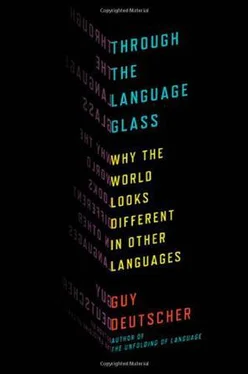On the basis of a few ancient texts and supported only by inspired inferences from some faint etymological traces, he thus reconstructs a complete chronological sequence for the emergence of sensitivity to different prismatic colors. Mankind’s perception of color, he says, increased “according to the schema of the color spectrum”: first came the sensitivity to red, then to yellow, then to green, and only finally to blue and violet. The most remarkable thing about it all, he adds, is that this development seems to have occurred in exactly the same order in different cultures all over the world. Thus, in Geiger’s hands, Gladstone’s discoveries about color deficiencies in one ancient culture are transformed into a systematic scenario for the evolution of the color sense in the whole human race.
Geiger went further than Gladstone in one other crucial respect. He was the first to pose explicitly the fundamental question on which the whole debate between nature and culture would center for decades to come: the relation between what the eye can see and what language can describe. Gladstone had simply taken it as read that the colors on Homer’s tongue matched exactly the distinctions his eye was able to perceive. The possibility never even crossed his mind that there could be any discrepancy between the two. Geiger, on the other hand, realized that the relation between the perception of color and its expression in language was an issue in need of addressing. “What could be the physiological state of a human generation,” he asked, “which could describe the color of the sky only as black? Can the difference between them and us be only in the naming, or in the perception itself?”
His own answer was that it is highly unlikely that people with the same eyesight as us could nevertheless have made do with such strikingly deficient color concepts. And since it is so unlikely, he suggests that the only plausible explanation for the defects in the ancients’ color vocabulary must be an anatomical one. Geiger thus rounds off his lecture by throwing down the gauntlet to his audience and challenging them to find the explanation: “The fact that color words emerge according to a definite succession, and that they do so in the same order everywhere, must have a common cause.” Now you naturalists and physicians go figure out the evolution of color vision.
As we shall see a little later, clues from an unexpected source started cropping up shortly after Geiger’s lecture, which-if anyone had taken notice-should have pointed to an entirely different way of explaining Gladstone’s and Geiger’s discoveries. There are some tantalizing hints in Geiger’s own notes that suggest he had become aware of these trails and was beginning to realize their importance. But Geiger died in media vita , only three years after delivering his lecture, while still in the thick of his research into the language of color. The clues went unheeded, and instead the following decades would be spent in pursuit of a bright red herring.

The person who decided to take up Geiger’s challenge was an ophthalmologist by the name of Hugo Magnus, a lecturer in eye medicine at the Prussian university of Breslau. A decade after Geiger’s lecture, in 1877, he published a treatise, On the Historical Evolution of the Color Sense , which claimed to explain exactly how the human retina developed its sensitivity to color over the course of the last few millennia. Magnus may not have been a thinker of Gladstone’s or Geiger’s stature, but what he lacked in genius he made up for in ambition, and it is largely to his credit that the question of the ancients’ color sense came into the public eye. His campaign to promote his ideas was greatly helped by a train of events which had nothing to do with any philological preoccupations but which nevertheless brought the subject of defective color vision into the public arena with a resounding great crash.
On the night of November 14, 1875, two Swedish express trains collided on the single-track main line between Malmö and Stockholm. The late-running northbound train was due to make an unscheduled stop at a small station to let the southbound train pass. The train slowed on approach to the station, but then, instead of obeying the red stop light and coming to a complete halt, it suddenly sped out of the station again, ignoring the lineman who ran after it frantically waving a red lamp. A few miles later, near the small village of Lagerlunda, it collided head-on with the southbound express, causing nine deaths and many injuries. Such disasters on the fledgling railway system were a matter of great horrified fascination, and the accident was widely reported in the press. After an inquiry and trial, the stationmaster was duly convicted of negligence in his signaling, dismissed, and sentenced to six months in prison.
But that was not the end of the affair, for a real-life Sherlock Holmes, a specialist in the anatomy of vision from Uppsala University, had an alternative hypothesis for what had led to the accident. Frithiof Holmgren suspected that the reason for the unexplained behavior of the northbound train was that the driver or the engineman, who had been overheard shouting something to the driver as they were speeding out of the station, mistook the red stop light for a white go light because he had some form of color blindness. Both the driver and the engineman died in the crash, so the suspicion could not be verified directly. And needless to say, the railway authorities flatly denied that any of their employees could have had a problem distinguishing the colors of the signs without it having been detected earlier. But Holmgren persisted and finally managed to persuade the director of one Swedish railway line to take him along on an inspection tour and let him test a large number of personnel.

Train crash in Lagerlunda, Sweden, 1875
Holmgren had devised a simple and efficient test for color blindness that used a set of some forty skeins of wool in different hues (see figure 2). He would show people one color and ask them to pick up all the skeins of similar color. Those who picked unusual colors, or even just unduly hesitated in their choice, would immediately stand out. Of the 266 railway workers Holmgren tested on just one railway line, he found thirteen cases of color blindness, among them a stationmaster and a driver.
The practical dangers of color blindness in an age of a rapidly expanding rail network thus became acutely apparent, catapulting color vision to a status of high public priority. The subject was rarely out of the newspapers, and within a few years governmental committees were formed in many countries, leading to mandatory testing for color blindness among all railway and marine personnel. The climate could not have been more favorable for a book which implied that latter-day color blindness was a vestige of a condition that had been universal in ancient times. And this was exactly the theory proposed in Hugo Magnus’s 1877 treatise on the evolution of the color sense. What Gladstone’s groundbreaking chapter never managed in 1858 (most people never got beyond the second volume, and the chapter on color was hidden at the end of the third), what even Geiger’s rousing lecture failed to accomplish in 1867, Magnus and the Lagerlunda train crash achieved ten years later: the evolution of the color sense turned into one of the hottest topics of the age.
Magnus’s treatise purported to provide the anatomical nuts and bolts, or rather nerves and cells, to Gladstone’s and Geiger’s philological discoveries. The perception of the ancients, Magnus wrote, was similar to what modern eyes can see at twilight: colors fade, and even brightly colored objects appear in indefinite gray. The ancients would have perceived the world in this way even in full daylight. To account for the refinements in the color sense over the last millennia, Magnus adopted the same evolutionary model that Gladstone had relied on two decades earlier, that of improvement through practice. The retina’s performance, he argued, “was gradually increased by the continuously and incessantly penetrating rays of light. The stimulus produced by the unremitting pounding of the ether particles continually refined the responsiveness of the sensitive elements of the retina, until they stirred the first signs of color perception.” These acquired improvements were inherited by the next generation, whose own sensitivity was further increased through practice, and so on.
Читать дальше













